Electric vehicle production requires engineers to complete several crucial manufacturing processes. Laser welding is essential to achieving target outcomes at high throughputs.
JOE KUCZYNSKI, SENIOR EDITOR
Propelled by legislation that aims to accelerate the adoption of electric vehicles (EVs), automakers around the world are facing growing pressures to ramp up production. Japan, Canada, and the U.K. are among the world powers that have already enacted policies that will require all new cars on the market to be electric by 2035. In the U.S., individual states are at various stages of implementing EV mandates, further signaling a forthcoming wave of e-mobility technologies.
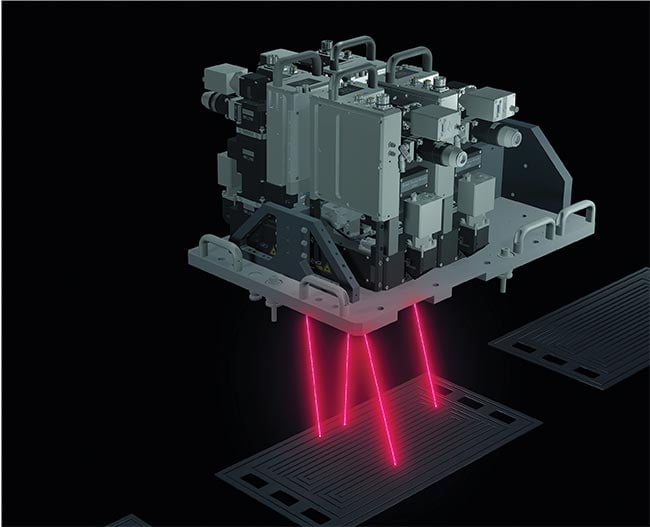
In the manufacturing of electric vehicles
(EVs), laser welding bipolar plates, battery
contacts, hairpins, and surface coolers for
car battery trays are essential processes. Courtesy of Scansonic.
Although early adopters have many
options for this next-generation technology, not all consumers are prepared to make the change to EVs. Concerns over battery life, a lack of established charging infrastructure, and a basic unfamiliarity
are among the factors that bind many would-be buyers of EVs to gas-powered vehicles.
These considerations fail to address the ultimate concern facing consumers. If EVs are to win over skeptics, champions of the technology must convince drivers that EVs will meet affordable cost targets.
For EV manufacturers, laser welding is a vital practice, enabling the joining of dissimilar materials, facilitating the processing of lighter parts, and adding levels of precision necessary for various distinct production steps. In addition to being a high-quality method to produce these vehicles, laser welding also helps to lower costs by eliminating waste and improving vehicle efficiency. Current welding capabilities enable fabricators to bypass the use of filler materials that certain applications require and to use fewer materials overall as a result.
With these advantages, however, some companies, at various positions in the EV manufacturing production chain, demand more from the systems that enable these critical manufacturing process steps. The properties of the materials used in vehicle production call for light and high-quality welds, and the need to produce them at high volume is driving laser manufacturers to refine efforts to improve commercial laser welding systems.
Applications within the application
Though iterations of the current common
laser welding systems have been in place for roughly a decade, laser welding has progressively improved in terms of both speed and quality. Recently, a shift in commodity weight shares — namely, higher usage of aluminum and copper — has expanded opportunities for laser welding, especially in the EV space.
Fundamentally, this shift and the
opportunities it establishes underscores the thousands of laser welds that are at the heart of every battery pack that is used to power an EV.
One application, joining cells to bus bars, is vital to meeting the stringent electrical requirements for consumer EVs. A poor connection can hinder the effective performance and reliability of the vehicle as well as the safety of its passengers. Battery modules are produced by joining battery cells and welding them using high-conductivity bus bars. Laser welding ensures that manufacturers can fabricate these joints in a consistent and high-quality manner.
The cell structures of these batteries comprise three layers: anode, separator,
and cathode foils. Lasers are an established solution for cutting these foils, which play a vital role in keeping electrodes separate and mitigating the risk of a short circuit. The same benefits that lasers deliver to bus bar joining — high speed, contact-free operation, and high precision — also transfer to this application. Additional benefits include flexible pattern cutting and improved edge quality.
From cutting separator foils with a dust and chemical-free process to ablating
battery casings, bus bar, and hairpin coatings in a quick and clean process, lasers are indispensable in e-mobility production as it relates to the processing of batteries and their materials. Still, laser welding extends to additional processes in the manufacturing process chain; while battery production is a leading application
for laser welding, manufacturers demand exceptional joint quality with high throughput and a high yield of parts. Laser welding meets these requirements as a highly repeatable noncontact process for creating mechanically strong joints.
The marriage of e-mobility and lasers
Markus Kogel-Hollacher, head of R&D projects at Precitec Group, a developer and manufacturer of system technology for laser material processing and sensors for quality control, leaves little to the imagination in his assessment of the relationship between e-mobility and laser sources. “There is no e-mobility without lasers,” Kogel-Hollacher said. From cell to car, welding with high-power lasers has proved its importance in the production of batteries for EVs.
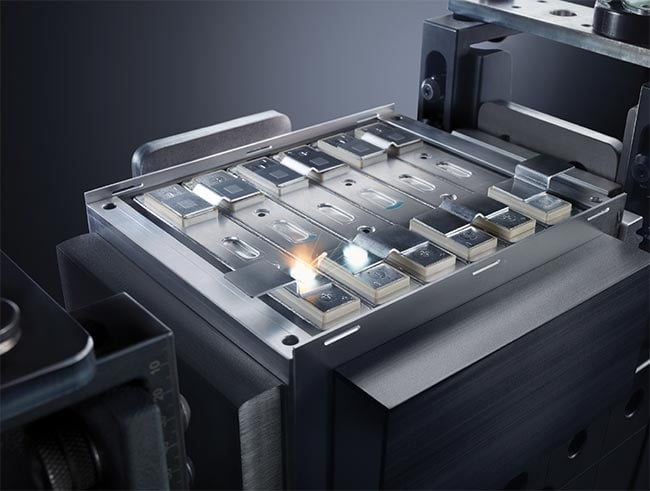
Electric vehicles (EVs) and power storage use thick copper bus bars. The development and processing of these components requires high laser powers and excellent beam quality. Courtesy of TRUMPF Inc.
The broad efficacy of the technique stems from several distinct advantages. One, the utility that laser welding offers in making EVs lighter in weight contributes to finished-vehicle efficiency by optimizing miles per charge. Laser welding enables manufacturers to shift from bolted constructions to welded ones that provide the necessary degrees of strength at a much lighter weight. Laser welding also enables the joining of materials that could not be welded by more conventional methods. Current manufacturing practices rely on laser welding to join disparate and dissimilar materials, including aluminum, copper, high-strength steel, and fiber-reinforced materials.
To quantify the success that laser welding has had in both the automotive and e-mobility sectors, consider its influence on productivity and quality. EV manufactures that performed laser welds in 2017, for example, typically used machines that achieved a rate of 60 mm/s for can-cap welding on prismatic battery cells, according to estimates from laser manufacturer TRUMPF Inc. Since then, the speed has more than octupled, the company said, with current laser welding machines on the market reaching up to 500 mm/s.
Considering the number of welds in each battery pack, increasing weld speeds can eliminate both common and persistent bottlenecks in assembly line processes. Today’s more advanced lasers can also “weld on the fly” — a process in which robots weld battery packs in one continuous motion. This cuts the cycle time by anywhere from 20% to 40%.
Such a considerable increase in speed, in a relatively short period, may suggest a loss to the overall quality of the weld. However, according to data from Travis Stempky, head of laser applications for TRUMPF Inc., welds that current market models perform have an improved yield rate of 99% or higher since 2017.
This twofold improvement is crucial to manufacturers achieving and sustaining cost savings.
“If you combine this productivity improvement and quality improvement, we can calculate cost savings,” said Pierson Cheng, battery industry manager for TRUMPF Inc. According to Cheng, new laser welding systems allow parts to be mass produced, including batteries and cars, at a consistent pace. This meets the need of manufacturers to produce high volumes of vehicles quickly without sacrificing quality.
Waste reduction, achieved by a more efficient use of materials, is an additional consideration, both for production and quality as well as cost savings. Cutting down on scrap material saves manufacturers money and reduces their reliance on other industries that may otherwise be called upon to provide these materials.
Pravin Sievi, senior product manager for remote laser processing systems at Scansonic, said that the performance advantages that current laser welding delivers to manufacturing processes are dynamic. This, he said, makes it difficult to regard advanced processes now used in manufacturing settings as conventional welding, or welding in a traditional sense.
“In batteries, most used alloys do not develop a crystalline joint after solidifying,” Sievi said. “Due to the dissimilar materials, we are not ‘welding’ anymore, but rather it is solidifying inside something that resembles a Ziploc bag. To be able to make the Ziploc, we are melting a lot less material, with very small focus diameters. And it is holding in this kind of manner.”
Systems and solutions
For battery manufacturers, high-powered IR lasers, with powers ranging from 3 to 8 kW and beam parameter product values in the range of 2 to 4 mm mrad are popular choices. EV manufacturers commonly pair these lasers with added beam optimization mechanisms to deliver the power and speed necessary for EV production.
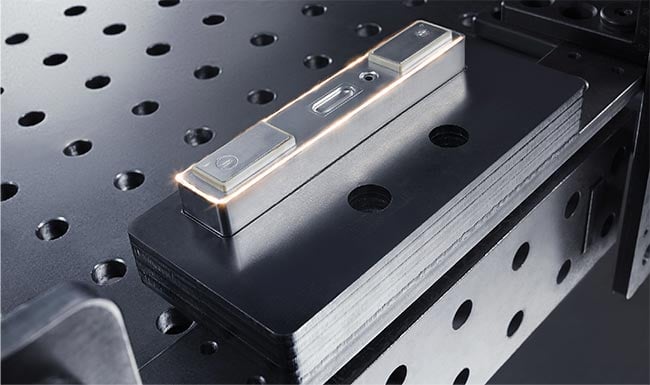
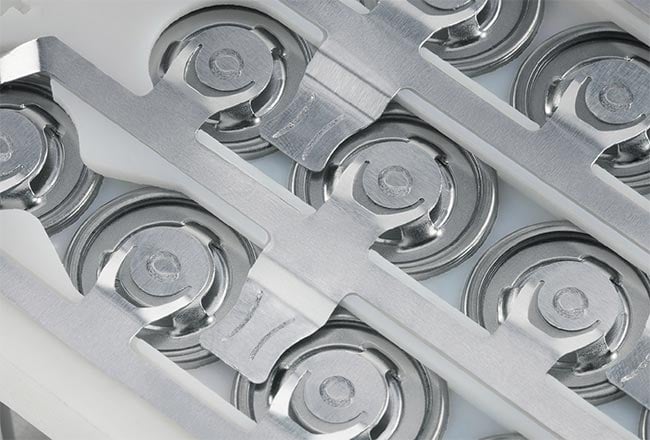
Sealing the prismatic battery housing requires spatter-free welding, process stability, and a weld that is media-tight without pores, cracks, or unwanted seam buckling (top). To produce prismatic battery cells, manufacturers may deploy lasers operating in the IR and/or visible bands (bottom). Courtesy of TRUMPF Inc.
Manufacturers also opt for visible sources, especially for electronic welding. Specifically for this application, engineers favor green lasers. These lasers can reach power levels comparable to those of their IR counterparts while minimizing spatter and achieving consistent weld penetration. More broadly, green and blue lasers have proved to be suitable for welding dissimilar materials, such as aluminum and copper, because the absorptivity of the shorter wavelength results in cleaner welds.
Lasers operating in both the IR and visible are used to produce prismatic battery cells. Lasers for this application generate 40 battery cells per minute. This compares to eight parts per minute earlier this decade, as estimated by laser maker TRUMPF Inc.
And, using single mode lasers, Sievi said, manufacturers are commonly working with a mode field of, for example,
15 µm with a focus diameter of 60 to
70 μm. These small beams deliver the advantage of a reduced heat affected zone.
Such precision requires advanced
optics and devices that can scan, drive, and position items for welding while working in synchronization with the laser source on a microsecond timescale. Communication between the lasers and welding optics ensures consistency and quality on the mass scale needed to support volume manufacturing.
Elsewhere, ultrashort-pulse and CO2 lasers have proved to be ideal options for battery cell shaping and electronic component refinement. Multiple laser companies have developed these solutions, and now offer lasers in these classes to meet the rising demands that they are seeing from automakers.
Laser surface structuring is a promising technology for improving the lifetime and performance of battery electrodes. With great precision, noncontact processes, and speed, it is a viable candidate for large-scale battery production. Luxinar, a developer of CO2 laser sources of up to 1000 W as well as ultrashort-pulse laser sources, expects these lasers to play a large role in the future of battery development.
“Battery technology today is all about increasing power density, and laser processes are being developed to advance this,” said Yannick Galais, sales director with Luxinar.
“At high power densities during fast charging or discharging processes, lithium separation is currently an issue. Femtosecond laser surface structuring uses ultrashort pulses of laser light to introduce micropores into the active layer of the battery electrodes, thus mitigating the problem.”
Pushing for laser welding
In addition to the unparalleled efficiency gains, several other drivers are facilitating the use of laser processes in e-mobility. According to Stempky, none is more prolific than the push for high-quality and consistent welds, which are persistent needs for manufacturers.
“As we are going to higher and higher volumes, How do we increase the yield rate [with] less scrap rate, [and] How do we ensure that we are getting good quality without testing every single weld that we are [performing], are questions we must ask,” Stempky said. “The laser is a tool that is very repeatable.”
Repeatability is especially important because the production volumes that consumer demand places on manufacturers are driving the need for increased laser welding. Simultaneously, new designs often lean heavily on laser welding to perform necessary operations that cannot be completed by other means. “One example is the foil welding from the batteries themselves,” Cheng said. “Traditionally, these are an ultrasonically welded part. But there is a limitation to the thickness of that foil stack with ultrasonic welding.”
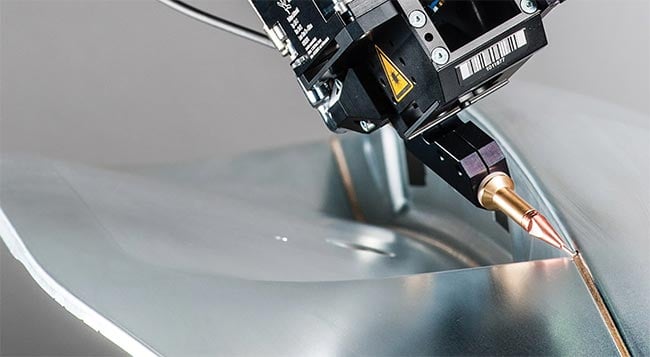
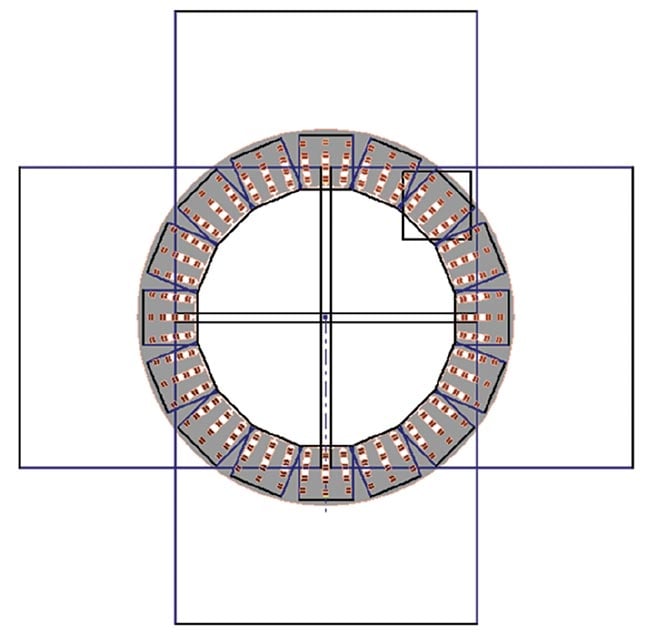
Laser sources used to alter material properties are widely used in and for laser welding to optimize the process itself as well as ensure target outcomes for welds (top). Using the example of a stator with hairpins, 16 fields of view and four scan fields are created. The hairpins can be manufactured in this way
in one work step (bottom). Courtesy of Scansonic.
“So, as companies want to make more compact battery cells and make each battery itself a little bit higher charge rate, they want to go [with] more foil stacks and lasers, allowing them to go to a higher foil stack welding.”
Automation and AI
Major technological advancements have made laser welding more powerful, more precise, and more adaptable in the last five years.
Still, according to Stempky, improving laser welding’s prospects for automation, rather than improvements to strength, are likely to characterize the future direction of this laser process.
“The future is all related to quality monitoring,” Stempky said. “The tech has come very far but how do we use it for an in-line look at quality? How do we use lasers to detect flaws in our welds and use automation and AI to adjust on the fly?”
According to Stempky, the quality of the weld is measured through weld depth, weld interface width, and electrical conductivity through the joint. AI, he said, can help to assess these measures quickly and accurately. And, according to Stempky, lasers and automation go hand-in-hand because of the sheer precision of the types of processes in which they are used. Soon, AI may be able to assist in not only detecting flaws and defects but also programming lasers to correct them in real time. Already, AI can detect a weld that does not meet quality standards, alerting to a technician that a correction is needed.
“While the focus today is on improving energy density, reducing cost, and developing alternative chemistries, automation and AI will be playing a significant role in the production of EVs, particularly in laser technologies, which are vital for precision manufacturing,” Galais said.
AI-driven process control could improve laser cutting of complex geometries in battery electrodes, ensuring high precision and minimal waste by adjusting parameters in real time. This ensures optimal quality and reduces errors or defects, which is particularly important when dealing with high-volume battery production.
AI systems could also monitor laser machinery in real time, predicting when maintenance is needed to prevent downtime. This keeps the production line moving efficiently, especially in large-scale battery manufacturing for EVs.
According to Galais, “In [the] near future, we could envisage that AI models could analyze data from production to improve how lasers interact with different materials, adjusting cutting paths or parameters dynamically. This would lead to higher efficiency, reduced energy consumption, and better material utilization.”
Limitless laser welding
As demand pushes the production of EVs, laser welding continues to play an integral part in manufacturing. For numerous applications, including many outside the realm of battery assembly and EV production, it is likely that laser welding will either remain or become an optimal process.
In fact, it is likely that many laser-based and laser-enabled manufacturing processes will outlast the e-mobility era. If the necessary infrastructures do not progress at the same rate as EV production, manufacturers may consider allocating time and resources for the development of hydrogen-powered or fuel cell-powered automobiles. Regardless of the power source, laser welding is bound to play a critical role.